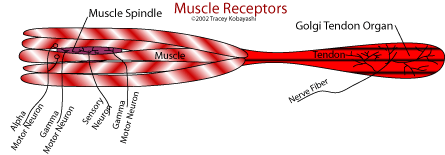
Week 7: Neural
Motor Function
|
Intro |
Synapses |
Receptors & Circuits |
|
Motor Function |
Autonomic System
|
Sensory information is integrated at all levels of the nervous system to cause appropriate motor resonses. These can range from simple spinal cord reflexes to more complicated responses in the brain stem, to the most complicated responses in the cerebrum.
Spinal Cord
Sensory signals entering the cord travel in two directions. One branch terminates in the cord's gray matter to elicit local reflexes, while another branch transmits to higher levels of the nervous system -- higher levels in the cord, brain stem, or cerebral cortex. Each spinal cord segment contains millions of neurons, which include the relay neurons as well as anterior motor neurons and inter neurons.
Anterior Motor Neurons give rise to nerve fibers that innervate the skeletal muscle fibers, and are of two types. Alpha motor neurons are large and stimulate the large skeletal muscle fibers. Each nerve fiber excites a group of fibers, collectively called a motor unit. Gamma motor neurons are smaller and transmit impulses to special muscle fibers called intrafusal fibers. These are part of the muscle spindle, which helps control muscle contraction.
Interneurons small and highly excitable neurons are more numerous than motor neurons. They interconnect with each-other and many dirrectly innervate the anterior motor neurons.
Muscle Receptors
Anterior motor neurons AND sensory feedback from muscles to the cord control muscle function. Muscle and tendons have two special sensory receptors, the muscle spindle and golgi tendon organ (gto).

Muscle Spindle: distributed through belly of muscle. Composed of intrafusal fibers containing little or no actin and myosin. Excites or inhibits by comparing length or change of length relative to surrounding fibers. Helps stabilize body position.
Golgi Tendon Organ (GTO): receptor in tendons. 10-15 muscle fibers
connect w/GTO in the tendon. Stimulated by change in muscle tension.
Muscle load is spread through all fibers, preventing local muscle damage when small numbers of fibers might be overloaded.
Both muscle spindle and gto have dynamic and static components. The dynamic components are active during change, while the static components continue to provide feedback after the dynamic reflex ends.
|
Intro |
Synapses |
Receptors & Circuits |
|
Motor Function |
Autonomic System
|